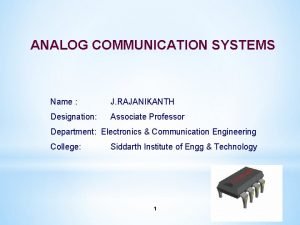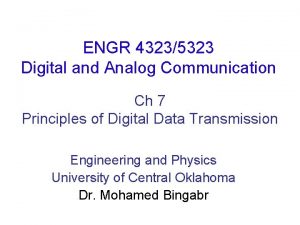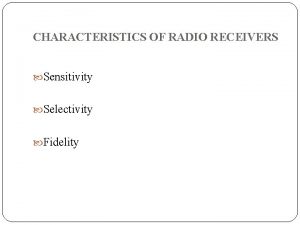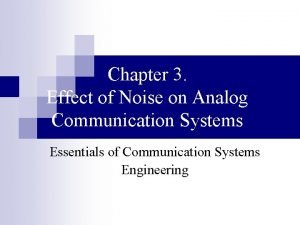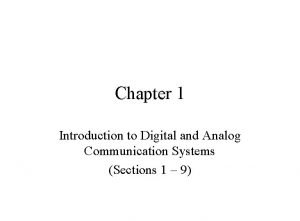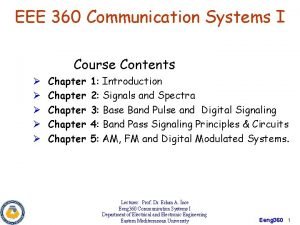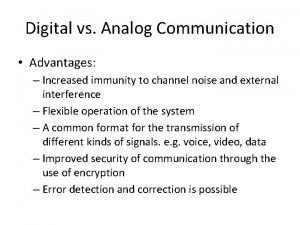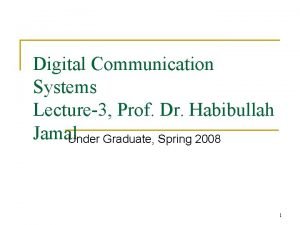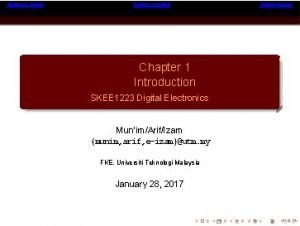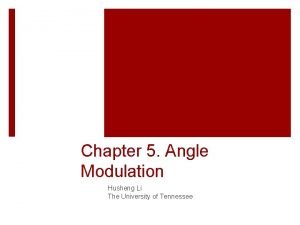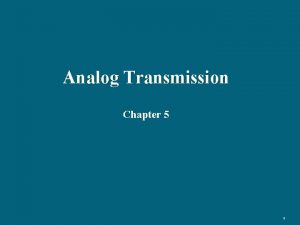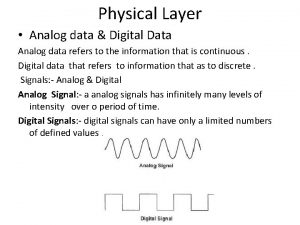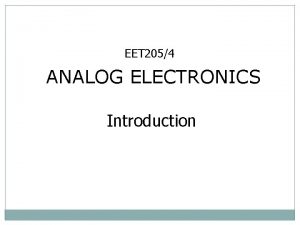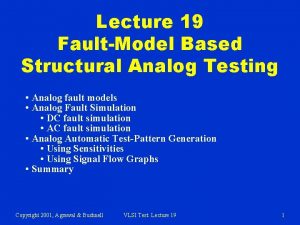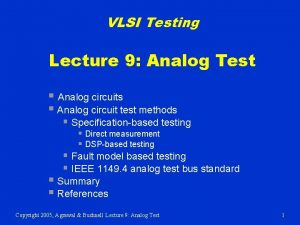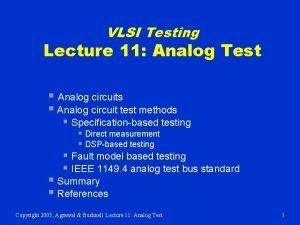Chapter 7 Analog Communication System Husheng Li The





































- Slides: 37

Chapter 7. Analog Communication System Husheng Li The University of Tennessee

Superheterodyne Receiver ¡Four tasks of the receiver: ¡ Demodulation ¡ Carrier frequency tuning ¡ Filtering ¡ Amplification of signal ¡In theory, all of the foregoing requirements could be met with a high-gain tunable bandpass amplifier. In practice, it is hard to achieve both selective and tuneable.

Superhet Principle ¡In the superhet principle, there are two distinct amplification and filtering sections prior to demodulation: RF section and IF section.

Parameters of AM and FM

Illustration of Spectrum

Direct Conversion Receivers ¡Direct conversion receivers (DC) are a class of tuned. RF (TRF) receivers that consist of an RF amplifier followed by a product detector and suitable message amplification.

Image Signal Rejection ¡The DC’s chief drawback is that it does not reject the image signal that is present in the opposite sideband is thus more susceptible to noise and interference.

Homework ¡Deadline: Nov. 18 th, 2013

Double Conversion Receiver ¡A double-conversion receiver takes the superhet principle one step further by including two frequency converters an two IF sections. The second IF is always fixed-tuned, while the first IF and second LO may be fixed or tunable.

Receiver Specification ¡ Receiver sensitivity is the minimum input voltage necessary to produce a specified signal-to-noise radio (SNR) at the output of the IF section. A good-quality shortwave radio typically has sensitivity of 1 u. V for a 40 d. B SNR. ¡ Dynamic range (DR) is ¡ Selectivity specifies a receiver’s capability to discriminate against adjacent channel signals. ¡ The noise figure indicates how much the receiver degrades the input signal’s S/N. ¡ Image Rejection is

Scanning Spectrum Analyzers ¡If the LO in a superhet is replaced by a VCO, then the predetection portion acts like a votlagetunable bandpass amplifier with center frequency f 0=f_LO +/f_IF

Operation of Spectrum Analyzer ¡The number of resolvable spectral lines equals ¡The IF output produced by a single line takes the form of a bandpass pulse with time duration ¡A rapid sweep rate may exceed the IF pulse response. Hence, we have ¡Hence, the accurate resolution (small B) calls for a slow rate and long observation time.

Multiplexing ¡The basic multiplexing techniques include FDM, TDM and CDM. The multiple access techniques include FDMA, TDMA and CDMA, and OFDM.

FDM

Crosstalk in FDM ¡The major practical problem of FDM is crosstalk, the unwanted coupling of one message into another. ¡Intelligible crosstalk arises primarily because of nonlinearities in the system which cause one message signal to appear as modulation on another subcarrier. ¡The crosstalk may also come from imperfect spectral separation by the filter bank.

Example: FDMA Satellite System

Quadrature-Carrier Multiplexing ¡Quadrature-carrier multiplexing, also known as quadrature amplitude modulation (QAM), utilizes carrier phase shifting and synchronous detection to permit two DSB signals to occupy the same frequency band.

TDM

Synchronization Markers ¡Markers are needed for time synchronization

Crosstalk and Guard Times ¡The filter design in TDM should be avoid inter-channel crosstalk. ¡A guard time is needed to avoid the crosstalk in TDM. ¡The crosstalk reduction factor is

Crosstalk in PPM ¡The avoidance of crosstalk in PPM requires

Comparison of TDM and FDM ¡TDM is readily implemented with high-density VLSI circuitry where digital switches are extremely economical. ¡TDM is invulnerable to the usual causes of crosstalk in FDM. ¡TDM may or may not be advantageous when the transmission medium is subject to fading. ¡Most systems are hybrids of FDMA and TDMA.

GSM ¡GSM is a hybrid of TDMA and FDMA

Homework ¡Deadline: Nov. 25 th, 2013

Phase Locked Loops ¡A PLL uses phase comparator

Phase Dynamics in PLL ¡The instantaneous angle in PLL is given by

Dynamics in PPL ¡The dynamics of the phase error are described in the nonlinear differential equation: where the loop gain is defined as The steady state is given by

Convergence ¡A necessary condition for the stead-state solution is given by ¡When the error is very close to zero, we have the following approximation:

PLL Pilot Filter ¡We can use the following circuit to generate a sinusoid synchronized with the pilot:

Synchronous Detection ¡When there is no pilot (e. g. , in DSB), we can use the following Costas-PLL to lock the phase:

Frequency-offset Loop ¡We can use the following PLL to realize the synthesize the sum of two frequencies:

Frequency Multiplication ¡We can us the following PLL and frequency divider to realize the multiplication of a frequency with an integer:

Adjustable Local Oscillator ¡We can use the following circuits to obtain 100 k. Hz and 1. 6 MHz and adjustable LO that covers 9. 90— 9. 99 MHz.

Quiz ¡Use the following figure to explain the purpose of phase locked loop and its operation procedure:

Linearized PLL ¡The frequency domain model of PLL can be obtained by linearizing the PLL:

FM Detection ¡When the input is FM signal, the PLL can be approximated by a first-order lowpass filter: ¡The output is given by

Software Project ¡ Topic: Analyze the spectrum of AM and FM signals. ¡ Software: Matlab ¡ Tasks: ¡ 1. Consider triangle series shown in the right figure. Consider carrier frequency 200 Hz. Choose the modulation indices by yourself. ¡ 2. Sample the modulated signal. Plot the time domain curves of the AM and FM modulated signals. Determine the sampling rate by yourself. ¡ 3. Read the introduction to discrete Fourier transform (DFT) in Matlab (http: //www. mathworks. com/help/matlab/math/discrete-fouriertransform-dft. html) and the function fft (http: //www. mathworks. com/help/matlab/ref/fft. html). ¡ 4. Use function fft in Matlab to obtain the spectrum of the modulated signal. Compare the spectrum of AM and FM. ¡ 5. Change the parameters such as modulation index and draw conclusions on the impact of these parameters. -1 0 1 Time (seconds)
 Analog communication system
Analog communication system Block diagram of analog communication system
Block diagram of analog communication system Sensitivity and selectivity of radio receiver
Sensitivity and selectivity of radio receiver White noise in analog communication
White noise in analog communication Analog vs digital communication systems
Analog vs digital communication systems Digital to analog conversion in data communication
Digital to analog conversion in data communication Eee 360
Eee 360 Analog communication
Analog communication Analog communication
Analog communication Analog devices part numbering system
Analog devices part numbering system Digital vs analog video
Digital vs analog video S domain
S domain Introduction to analog and digital electronics
Introduction to analog and digital electronics Hát kết hợp bộ gõ cơ thể
Hát kết hợp bộ gõ cơ thể Lp html
Lp html Bổ thể
Bổ thể Tỉ lệ cơ thể trẻ em
Tỉ lệ cơ thể trẻ em Gấu đi như thế nào
Gấu đi như thế nào Thang điểm glasgow
Thang điểm glasgow Chúa sống lại
Chúa sống lại Các môn thể thao bắt đầu bằng tiếng nhảy
Các môn thể thao bắt đầu bằng tiếng nhảy Thế nào là hệ số cao nhất
Thế nào là hệ số cao nhất Các châu lục và đại dương trên thế giới
Các châu lục và đại dương trên thế giới Công của trọng lực
Công của trọng lực Trời xanh đây là của chúng ta thể thơ
Trời xanh đây là của chúng ta thể thơ Mật thư tọa độ 5x5
Mật thư tọa độ 5x5 Làm thế nào để 102-1=99
Làm thế nào để 102-1=99 Phản ứng thế ankan
Phản ứng thế ankan Các châu lục và đại dương trên thế giới
Các châu lục và đại dương trên thế giới Thể thơ truyền thống
Thể thơ truyền thống Quá trình desamine hóa có thể tạo ra
Quá trình desamine hóa có thể tạo ra Một số thể thơ truyền thống
Một số thể thơ truyền thống Cái miệng xinh xinh thế chỉ nói điều hay thôi
Cái miệng xinh xinh thế chỉ nói điều hay thôi Vẽ hình chiếu vuông góc của vật thể sau
Vẽ hình chiếu vuông góc của vật thể sau Nguyên nhân của sự mỏi cơ sinh 8
Nguyên nhân của sự mỏi cơ sinh 8 đặc điểm cơ thể của người tối cổ
đặc điểm cơ thể của người tối cổ Ví dụ giọng cùng tên
Ví dụ giọng cùng tên Vẽ hình chiếu đứng bằng cạnh của vật thể
Vẽ hình chiếu đứng bằng cạnh của vật thể
